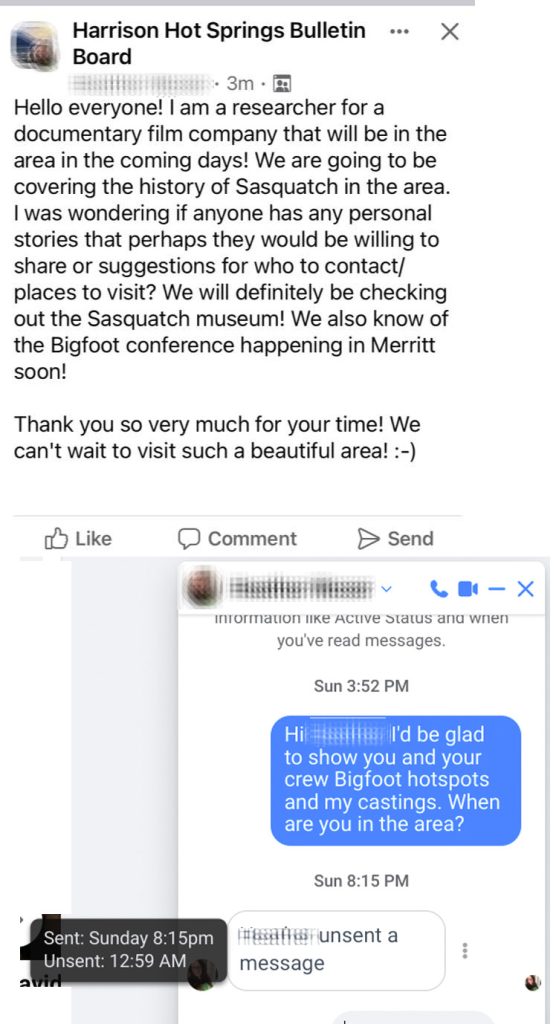Persona non grata in the Bigfoot World

per·so·na non gra·ta
noun
an unacceptable or unwelcome person.
“he was persona non grata with the regime”
So take a look at this interaction I had on Facebook last week:

Pay attention to that last bit. The researcher looking for help sends me a message at 8:15pm and then unsends it at 12:59AM and they or the production company never respond to any of my messages again.
That was just enough time for them to go watch the FFF doc and decide that they want nothing to do with me. That’s what working on that documentary film has done to my reputation in the Bigfoot community.
This isn’t the first time. Just the most recent. It looks like the last 5 years of my work have come to and end. Onto to new things. I’ll keep this though though, for historical reasons and I’ll just reuse parts of it or something…
New Name for New Projects

I’m the first to admit when I’m wrong. And I was really wrong about the documentary “Foot Finding Feats”. It released last Fall and is doing really well. Doing well enough that the accountants over at N3ZEN actually paid me my share of royalties! And they promise more to come. So ya, I was wrong. And even though they got a metric shit ton of stuff wrong in the film, they did at least come through with the cash.
So I learned a lot in that experience. And I learned a lot about camera work which resulted in my little project shooting cooking videos in the bush with the YouTube project Hannibal Crossing. Those aren’t doing as well but I had fun and again, I learned something.
So I’ve decided to hang out my shingle in this world of internet “Giggers” and produce my own works. The N3ZEN are still going to help me with marketing and distribution but it will be all my own work under the name “BIG WIN ZIG”. I know, clever huh? Ya, I didn’t bust my ass coming up with a name.
Upcoming projects are me finally finishing the book I’ve been writing for 5 years about my time in the DotCom world in Vancouver. And I’m working on my next film as well, but that will be at least a couple of years before it sees the light of day.
I’m not buying another god damn website so I’ll be putting my stuff on here under the BIG WIN ZIG web page. But I’ll still keep updates on this blog.
l8r!

It seems I can’t keep away from video cameras. Last summer I recorded a bunch of footage of me cooking on the trail and it’s now being put together as little YouTube videos.
“Hannibal Crossing” are short videos where I will show you scrumptious and nutritious recipes ideal for hiking and camping. From light and simple to gourmet and complex.
The link to the YouTube playlist is here: https://youtube.com/playlist?list=PLrK5L92Z2METgZRAJDdq3UnrLTVqpVEIE
Is Bigfoot just a Bear?

Many skeptics argue that Bigfoot is simply a misidentification of other known animals, such as bears. Bears have long been known to walk upright on their hind legs, giving them a human-like appearance. This behavior is often observed when bears are searching for food, such as berries or insects, or when they feel threatened. In some cases, this upright stance can be mistaken for a bipedal creature like Bigfoot.
Furthermore, bears have a distinctive odor that can be mistaken for a pungent, musky scent often reported by Bigfoot witnesses. Some bear species, such as the North American black bear, have shaggy fur that can resemble the hair often described in Bigfoot sightings. Additionally, some bears can grow to be over six feet tall when standing upright, making them a plausible explanation for Bigfoot sightings.
While Bigfoot continues to capture the imagination of people all over the world, the possibility that these sightings are simply misidentified bears cannot be ignored. Until there is concrete evidence to support the existence of Bigfoot, the creature will remain a mystery, with bears serving as a plausible explanation for some reported sightings. Nevertheless, the search for Bigfoot continues, and the possibility of discovering a new species or discovering new evidence remains intriguing to many.
Read Floe Foxon’s Research paper on this topic for more info

Grover Krantz was an American physical anthropologist and professor best known for his research on the Bigfoot phenomenon. He was born on December 22, 1931, in Denver, Colorado, and received his PhD in anthropology from the University of Michigan in 1957. Krantz was a faculty member at Washington State University for over 30 years, where he conducted extensive research on the morphological and behavioral characteristics of primates.
Krantz’s interest in Bigfoot began in the 1960s when he first saw the famous Patterson-Gimlin film, which purports to show a female Sasquatch. He was intrigued by the creature’s anatomy and became convinced that it was a real animal, rather than a hoax. Over the years, Krantz conducted extensive research on the subject, including analyzing the film and studying footprints, hair samples, and other physical evidence. He also wrote several books on the topic, including “Bigfoot Sasquatch Evidence” and “Bigfoot: The Yeti and Sasquatch in Myth and Reality.”
Despite his belief in the existence of Bigfoot, Krantz faced criticism from his peers in the scientific community, who dismissed the creature as a myth. Nevertheless, Krantz remained committed to his research and continued to study the evidence until his death on February 14, 2002. Today, his work remains controversial and polarizing, but it has helped to keep the conversation about the possibility of the existence of Bigfoot alive.
Grover Krantz was also known for his research on the domestic dog and its relationship to the gray wolf. He studied the skeletal structure and morphology of both species, and was a vocal advocate for the idea that dogs are domesticated gray wolves. He believed that the process of domestication had resulted in the development of a subspecies of wolf, which he called Canis lupus familiaris. He argued that this subspecies was distinct from the gray wolf and should be recognized as its own species.
Krantz also studied the behavior of domestic dogs, and was particularly interested in the process of dog domestication. He argued that the domestication of dogs was a gradual process that occurred over thousands of years, and that the domesticated dog and the gray wolf were still capable of interbreeding. He also believed that the domestication of dogs was a key factor in human evolution, as the ability to domesticate animals was a crucial step in the development of human civilization. Krantz’s work on the domestication of dogs was well received by the scientific community and is considered an important contribution to the field of animal behavior and evolution.
After losing a battle to cancer, Krantz’s skeleton and his giant Irish Wolfhound Clyde are now on display at the Smithsonian’s National Museum of Natural History as seen above.
The NDA I signed expired
The Non-Disclosure Agreement (NDA) that I signed with N3ZEN expired finally. Thank goodness my lawyer looked over that paperwork and forced them to put an expiry date into it. To be honest I think they are past caring about me or the project. It’s out and they’ve moved onto to the next thing.
So I made this video to address some of the feedback I’ve got about my role in the documentary.
If you have any more questions, then fire away cause I can answer them now.
This will be the last video from me. It’s time to move on from this Bigfoot stuff. I’m on old man now and I keep thinking about the past, the time before Bigfoot. So I’m writing a book about my days in Vancouver in the 90s. Stay tuned for more details….
New Trail Camera at Sasquatch Mountain, BC
Trying a new Trail Camera that was gifted to me. I am here at Sasquatch Mountain, BC and continuing my search for proof of Bigfoot.
It’s been a busy summer that has been taking away from my Bigfoot Finding time. And that documentary has been stealing time as well. They are working to get a distributor. We’ll see how it works out.
Some Bigfoot Gifts from the Crew

I have to say the documentary crew have been really supportive and I did actually make some friends working with them.
If this seems like a complete turn about I guess it is. After having family members see the film and talk to me about my experiences it kind of put it all into perspective.
She must have got these at the gift shop in Harrison.
I’ve been told to expect to make some time for interviews and press work this summer. It’s raining constantly anyways so I don’t think I’m going to my remote camp up north for a while.
Foot Finding Feats
Bigfoot Found or Fraud
A documentary crew interviews a Bigfoot “Finder” over a two year period. His family shares his lost footage from the wilds of Sasquatch Mountain, British Columbia. He was declaring his proof of Bigfoot’s existence, origin and purpose. But is it true? And is he safe?
Watch the whole film for free: https://tubitv.com/movies/687661/foot-finding-feats-bigfoot-found-or-fraud Or just search “Foot Finding” in the Tubi app on your TV.




